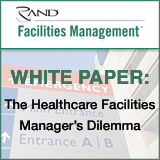The Healthcare Facilities Manager’s Dilemma: How to Ensure Compliance While Driving Down Costs

 Given that medical care can make the difference between life and death, it’s not surprising that hospitals and healthcare organizations are highly regulated in the United States and throughout the developed world. In the United States alone, hospitals must comply with regulatory requirements from more than 25 state and federal agencies. It’s no surprise that compliance is top of mind for healthcare facilities managers, but another high priority is keeping costs under control. That means operating facilities as efficiently as possible.
Given that medical care can make the difference between life and death, it’s not surprising that hospitals and healthcare organizations are highly regulated in the United States and throughout the developed world. In the United States alone, hospitals must comply with regulatory requirements from more than 25 state and federal agencies. It’s no surprise that compliance is top of mind for healthcare facilities managers, but another high priority is keeping costs under control. That means operating facilities as efficiently as possible.From a compliance perspective, here are just a few examples of the regulations facilities managers face: The Joint Commission (TJC)
- To earn or maintain TJC accreditation, hospitals must comply with standards-based performance in 17 different areas. Standards related to facilities management include Environment of Care and Life Safety. Environment of Care defines the requirements of all environmental management programs for facility and clinical operations staff, while the TJC Life Safety standard has significant overlap with the National Fire Protection Association’s Life Safety Code®.
- Healthcare facilities managers must also complete a Statement of Conditions™ (SOC) compliance document which helps hospitals create and maintain a fire safe environment of care. It also demonstrates compliance with the intent of standards that require newly constructed and existing environments of care to be designed and maintained in conformance with the Life Safety Code (LSC). The SOC includes Basic Building Information, a Life Safety Assessment, and Plan for Improvement which describes the organization’s plan to resolve identified LSC deficiencies. Click here to download the RAND FM White Paper.
